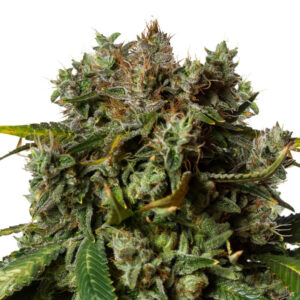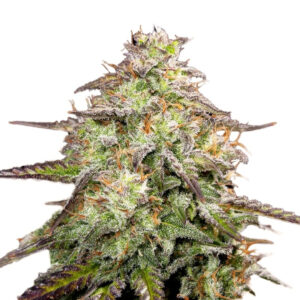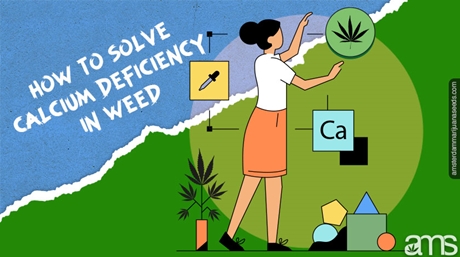If you’ve ever asked yourself how big do autoflowers get, you’re not alone. Whether you’re a first-time grower or an experienced cultivator, understanding the final size of your autoflowering plants is essential to planning a successful grow. These strains are known for their speed and compact growth—but that doesn’t mean they’re all the same size.
In this guide, we’ll answer the question how big do autoflowers get by looking at the relationship between plant size and pot size. From small containers that promote stealthy growth to larger pots that support bigger yields, we’ll help you choose the best setup for your space, your growing goals, and your strain. Let’s dig in!
Choosing the right container is crucial when you’re trying to understand how big do autoflowers get. Pot size has a direct impact on how tall and wide your plant can grow, how well its root system develops, and ultimately, how much yield you’ll harvest. Autoflowers operate on a fixed life cycle, so there’s no time for setbacks—especially if your plant becomes root-bound early.
Go too small, and your autoflower may stay undersized, limiting bud production. Go too big, and you risk overwatering or wasting valuable space. By matching pot size to your grow environment and goals, you can help your plants grow efficiently and reach their full size potential. Understanding how big do autoflowers get helps you avoid common pitfalls and maximize every inch of growth.
Autoflowering cannabis plants have a short life cycle, which means they don’t have time to recover from stress—especially root stress. That’s why understanding how big do autoflowers get is essential when choosing the right pot. The container size impacts how far the roots can grow, how stable your plant becomes, and ultimately, how much it yields.
Too small, and your plant becomes root-bound early, leading to stunted growth and smaller buds. Too large, and your medium may hold excess water, increasing the risk of overwatering and nutrient waste. The goal is to match the pot size to the plant’s expected size, so your autoflowers thrive without wasting resources. Knowing how big do autoflowers get helps prevent common mistakes and sets you up for success.
If you’re just getting started, check out our selection of autoflower seeds or explore our autoflower week-by-week guide for insights on each growth stage.
When growing autoflowers, your pot size should reflect your growing style, space, and goals. While there’s no one-size-fits-all, here are some general guidelines for choosing the right container size. Understanding how big do autoflowers get depending on your setup is key to maximizing space and yields.
If you’re working with limited vertical space or want to grow multiple small plants, opt for 1.5 to 2.5-gallon (6.5–9.5 L) pots. This range supports compact plants while keeping them manageable indoors. Many growers use this setup in a Sea of Green (SOG) style to maximize yield per square foot.
This method is ideal if you’re cultivating fast-flowering strains that perform well in controlled spaces. For inspiration, explore our post comparing autoflower vs feminized seeds and find the perfect fit for your grow room. Just make sure your pots provide good drainage and airflow to support root health.
For average-sized autoflowers, 3 to 5-gallon (11–19 L) pots are ideal. This size allows enough room for the roots to spread while encouraging strong vegetative growth. It’s a great option for growers who want quality yields from individual plants without them taking over the grow tent.
If you’re wondering how big do autoflowers get in this pot range, expect balanced plants that stay under 3 feet tall but deliver satisfying yields. Consider pairing these containers with stable genetics from our feminized seed selection if you’re experimenting with hybrid setups.
If you’re aiming for maximum growth from fewer autoflowering plants, go for 5 to 7-gallon (19–26 L) pots. These are especially useful for outdoor growing or large grow rooms where space isn’t a limiting factor. Just keep in mind that larger pots may need more time for the root zone to fully develop.
So, how big do autoflowers get in larger containers? In the right conditions, they can reach heights of up to 4 feet with broader lateral branching and dense bud formation—perfect for growers focused on maximizing yield over plant count.

Beyond choosing the right pot size, selecting the proper pot material can also impact root development, moisture retention, and overall plant health. These factors ultimately influence how big do autoflowers get and how healthy their root systems become. Here are the most popular pot types used by autoflower growers:
Fabric pots are a favorite among growers for a reason. They offer excellent drainage and encourage air pruning, which prevents root circling and promotes healthier root systems. These pots also help regulate temperature and prevent overheating during hot days.
Although slightly more expensive than plastic containers, fabric pots are reusable, eco-friendly, and ideal for maximizing airflow and moisture control—two key aspects that influence how big do autoflowers get. They’re especially recommended for growers who want to push their plants to full potential.
Beyond choosing the right pot size, selecting the proper container material also plays a vital role in root health, moisture retention, and plant development. These factors directly affect how big do autoflowers get throughout their short life cycle. Below are the most popular pot types used by autoflower growers and how each one influences plant size and performance:
Fabric pots are a favorite among growers for good reason. They offer excellent drainage and encourage air pruning, which prevents root circling and promotes a more efficient root system. These breathable containers also help regulate temperature and prevent overheating during hot days. Though slightly more expensive, they’re reusable, durable, and eco-friendly—making them a top choice for growers wondering how big do autoflowers get when provided with optimal root conditions.
Plastic containers are widely available, budget-friendly, and long-lasting. If you choose plastic, be sure the pots have ample drainage holes to prevent water retention and root rot. While they don’t provide the same breathability as fabric pots, they’re a decent option for beginners or those growing autoflowers on a tight budget. However, keep in mind that container material can influence how big do autoflowers get by affecting root health and airflow.
Terracotta is a classic material that naturally absorbs moisture, helping keep root temperatures down and minimizing the risk of overwatering. However, these pots can be quite heavy and fragile, so they’re better suited for stationary setups, especially in outdoor grows. While effective, they may not be ideal if you’re trying to maximize how big do autoflowers get due to their limited mobility and slower warming.
Air pots are rigid containers with perforated walls that allow maximum oxygen flow to the roots. Like fabric pots, they promote air pruning and prevent root-bound issues. Although a bit pricier than plastic or terracotta, air pots are excellent for boosting yields and encouraging vigorous root development—both critical factors in determining how big do autoflowers get under optimized conditions.

Once you’ve chosen your container, it’s time to make sure your setup supports healthy, vigorous plants. Whether you’re growing in fabric, plastic, or air pots, these are the most important features to consider when wondering how big do autoflowers get in each environment:
Drainage is non-negotiable. Your pot should allow excess water to escape freely, preventing waterlogging and root rot. Look for containers with multiple holes at the bottom, or consider drilling extra ones to ensure roots stay healthy throughout the grow cycle.
Autoflowers grow fast and don’t tolerate transplanting well, so your initial pot must provide enough space for roots to expand from day one. Choosing wisely here is key to maximizing how big do autoflowers get without stressing the plant or limiting its potential.
Always clean your pots—whether new or reused—to remove potential pathogens that could harm your seedlings. This step is essential for autoflowers, which have short life cycles and little time to bounce back from disease or contamination.
Depending on your grow space and plant size, select pots that offer a stable base. If your autoflowers are expected to get tall or top-heavy, consider using heavier pots or support systems like tomato cages or stakes to keep them secure as they develop.
One of the most important decisions you’ll make is selecting the correct autoflower pot size based on your available space, desired yield, and grow style. Whether you’re growing one large plant or running a dense Sea of Green setup, the size of your pots will directly impact your results.
If you’re planning to grow a few large autoflowers, opt for pots between 10–15 liters (2.6–4 gallons). This gives roots plenty of room to develop, supporting taller plants with more bud sites. Be mindful not to overdo it—going too big can lead to wasted soil and slower early-stage growth.
Growing multiple smaller autoflowers? Choose pots ranging from 6.5–8.5 liters (1.7–2.2 gallons). This works well in tight spaces and helps create a consistent canopy. Smaller pots also allow for faster veg and earlier flowering, making them ideal for quick turnaround harvests.
Whichever setup you choose, make sure your plants have enough light and airflow. Smaller pots mean less root mass, so it’s crucial to stay on top of watering and nutrients to avoid stress or deficiencies.
Once you’ve chosen the right autoflower pot size, it’s time to think about the pot material. Not all containers are created equal, and the type you choose can impact root health, moisture retention, and overall plant growth.
Fabric pots (also known as smart pots) are a top pick for autoflowers. Their breathable material allows for excellent air pruning and oxygen exchange, which promotes stronger root systems and prevents root circling. They’re also reusable and eco-friendly—great for sustainable grows.
Air pots are made from sturdy plastic with perforated sides. Like fabric pots, they encourage root pruning and deliver superb aeration. The design helps prevent overwatering and promotes faster growth. They can be pricier, but many growers find the investment worth it for the improved yields.
Terracotta is a classic material with natural wicking properties. It helps regulate moisture by absorbing excess water and slowly releasing it, keeping the root zone cooler in warm conditions. These pots are heavier and less forgiving if dropped, but they’re a solid option—especially outdoors.
Plastic containers are the most common choice for beginners due to their affordability and availability. Make sure they have adequate drainage holes, and consider drilling extra ones if needed. While they don’t offer the aeration benefits of fabric or air pots, they can still produce solid results with good soil and proper care.
Once you’ve chosen your container, it’s time to make sure your setup supports healthy, vigorous plants. Whether you’re growing in fabric, plastic, or air pots, these are the most important features to consider when wondering how big do autoflowers get in each environment:
Drainage is non-negotiable. Your pot should allow excess water to escape freely, preventing waterlogging and root rot. Look for containers with multiple holes at the bottom, or consider drilling extra ones to ensure roots stay healthy throughout the grow cycle.
Autoflowers grow fast and don’t tolerate transplanting well, so your initial pot must provide enough space for roots to expand from day one. Choosing wisely here is key to maximizing how big do autoflowers get without stressing the plant or limiting its potential.
Always clean your pots—whether new or reused—to remove potential pathogens that could harm your seedlings. This step is essential for autoflowers, which have short life cycles and little time to bounce back from disease or contamination.
Depending on your grow space and plant size, select pots that offer a stable base. If your autoflowers are expected to get tall or top-heavy, consider using heavier pots or support systems like tomato cages or stakes to keep them secure as they develop.
Getting the right pot size for autoflowers is a game changer. It influences your plant’s root development, height, health, and ultimately, your yield. Whether you’re growing a few large plants or a Sea of Green with smaller pots, tailoring your container to your space and goals will help determine how big do autoflowers get in your grow.
Just remember:
There’s no one-size-fits-all answer to how big do autoflowers get, but with this guide, you’re in a solid position to grow healthy, compact, and productive autoflowering cannabis plants. Happy growing!













Related Posts

Like us, plants need nutrients to live. So do your weed plants. The crop requires nutrients to germinate, vegetate, flower, and fight off pests and diseases. We have several kinds of crucial nutrients that your weed crop needs. The nutrients are classified into macronutrients and micronutrients.

Welcome to the ultimate guide on using grow bags for growing cannabis. Whether you’re a seasoned gardener or a cannabis enthusiast looking to cultivate your favorite strain, grow bags offer a versatile and efficient way to nurture healthy cannabis plants. In this article, we’ll answer the most frequently asked questions about grow bags for cannabis cultivation and provide valuable insights into their advantages, disadvantages, and optimal usage. Let’s dive in!

The Deep Water Culture (DWC) technique gets seen as the most challenging approach among many aspiring growers. As this article will show, it isn’t as hard as it is thought to be.